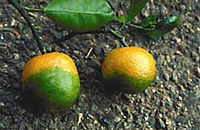
Photo from wikipedia
An outbreak of citrus greening or Huanglongbing disease bacteria occurs in many areas. We sampled and identified an ongoing ~year 2020 orange tree endemic in northern Thailand as Candidatus Liberibacter… Click to show full abstract
An outbreak of citrus greening or Huanglongbing disease bacteria occurs in many areas. We sampled and identified an ongoing ~year 2020 orange tree endemic in northern Thailand as Candidatus Liberibacter asiaticus. We thereby developed a plant greening disease (C. Liberibacter asiaticus) detection assay using simple alkaline heat DNA lysis and loop-mediated isothermal amplification coupled hydroxynaphthol blue (AL-LAMP-HNB), and evaluated the developed assay for its feasibility as point-of-care detection on 65 plant leaf samples with 100–1×104 copies of C. Liberibacter asiaticus or mocked injection compared with commercial DNA lysis kit and PCR-GE. Our assay is sensitive to 5–8.9 copies of omp (equaling 0.0056–0.01 fg) compatible with PCR-GE limit of detection. This ultra sensitive limit of detection could allow the disease detection before clinical apparent state of disease when C. Liberibacter asiaticus infection number is few, i.e. fewer than 100 copies of C. Liberibacter asiaticus. The assay is also specific with 6 degenerate primers targeting every strain of C. Liberibacter asiaticus omp from GenBank database, rapid (40 min total assay time), inexpensive (~2–3 USD/reaction), does not require sophisticated instrumentation, and has comparable assay accuracy (93.85–100% accuracy, 100% specificity, and 89.74–100% sensitivity) to bacterial DNA extraction by a commercial kit followed by PCR and gel electrophoresis (92.31% accuracy, 100% specificity, and 87.18% sensitivity) based on the real sample tests. Hence, the technique could be used in local or laboratory resource-restricted settings. The test result could be read by naked eyes through the color change from violet (negative) to sky blue (positive) for a C. Liberibacter asiaticus-infected specimen. Furthermore, this assay uses safe chemical reagents and, thus, is safe for the users.
Journal Title: PLOS ONE
Year Published: 2022
Link to full text (if available)
Share on Social Media: Sign Up to like & get
recommendations!